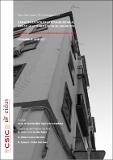Por favor, use este identificador para citar o enlazar a este item:
http://hdl.handle.net/10261/215108COMPARTIR / EXPORTAR:
 SHARE
BASE SHARE
BASE
|
|
| Visualizar otros formatos: MARC | Dublin Core | RDF | ORE | MODS | METS | DIDL | DATACITE | |

| Título: | Caracterización de la estanqueidad al aire de la vivienda social en Andalucía |
Otros títulos: | Airtightness assessment of social housing in southern Spain | Autor: | Fernández-Agüera, Jesica CSIC | Director: | Oteiza San José, Ignacio CSIC ORCID; Sendra, Juan José; Suárez, Rafael | Fecha de publicación: | 2018 | Editor: | Universidad de Sevilla CSIC - Instituto de Ciencias de la Construcción Eduardo Torroja (IETCC) |
Resumen: | Hygrothermal comfort, indoor air quality and energy consumption depend to a large extent on the airtightness of a property's envelope. While individual single-family properties have been extensively researched over the last three decades in northern Europe, the United States and Canada, there is only limited information on airtightness in multi-occupancy buildings in temperate climates. This thesis aims to characterise the airtight performance of envelopes in social housing stock in Andalusia from 1950 onwards, assessing impact on both energy and indoor air quality. Completing the work has required one hundred and fifty-nine pressurisation and depressurisation tests, in accordance with the procedure described in Standard UNE 13829:2002, as well as test protocols specifically adapted to the characterisation of the air infiltration performance of multi-occupancy residential buildings. These data are supplemented by a range of tests to check the location of the air ingress paths in the envelope of buildings under different conditions. Simultaneously, the most common envelopes and morphologies representing this housing stock have been identified and analysed. The surveys of the buildings are complemented by monitoring of a group of carefully-selected case studies to gather information on the evolution of their environmental variables: temperature, humidity, CO2, TVOC and PM2.5. These tests have made it possible to statistically analyse the main parameters associated with airtightness and to search for relationships with the construction and morphological characteristics of the properties. The work proposes two predictive airtightness models based on the specific characteristics of each property and building, a first model adapted to the characteristics of the properties built before basic standard NBE CT79 came into force, and a second model focused on properties constructed after this date. These models have a high degree of uncertainty associated with the dispersion of results, due to the random component of traditional construction, even in buildings with common characteristics and types of construction. Notwithstanding, the values recorded for airtightness are consistent with the findings of other tests in southern Europe, which place the stock in an intermediate situation. This characterisation is used to define a series of energy models for the properties under study, in order to assess the impact of airtightness on energy demand, both overall and seasonally, and its potential for reduction. The results show that the lack of ventilation means there is high exposure to pollutants during the cold season, causing unsuitable indoor environments, especially in the most hermetic properties. The increase in airtightness rate has most effect on properties built after NBE CT79 came into force, with the overall sample analysed requiring a balance between energy saving requirements and ability to renew the indoor atmosphere. | URI: | http://hdl.handle.net/10261/215108 |
| Aparece en las colecciones: | (IETCC) Tesis |
Ficheros en este ítem:
| Fichero | Descripción | Tamaño | Formato | |
|---|---|---|---|---|
| estanqueI.pdf | 32,43 MB | Adobe PDF |  Visualizar/Abrir | |
| estanqueII.pdf | 22,99 MB | Adobe PDF |  Visualizar/Abrir |
CORE Recommender
Page view(s)
125
checked on 19-abr-2024
Download(s)
421
checked on 19-abr-2024
Google ScholarTM
Check
NOTA: Los ítems de Digital.CSIC están protegidos por copyright, con todos los derechos reservados, a menos que se indique lo contrario.
